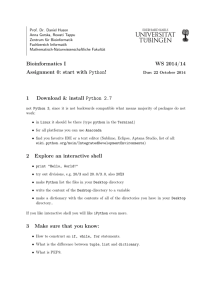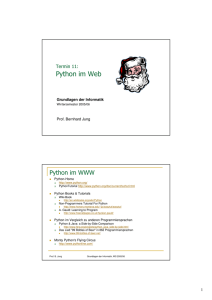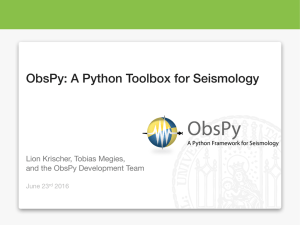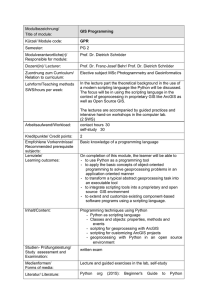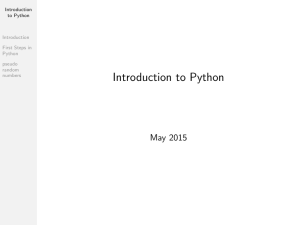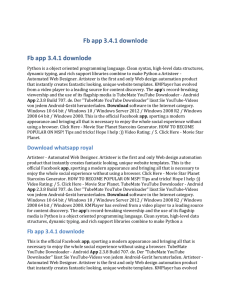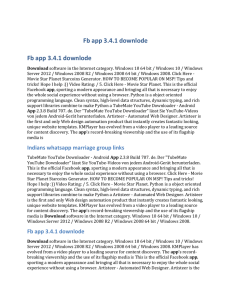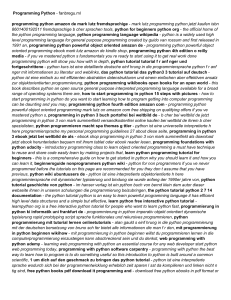David Schneider STUPS
Werbung
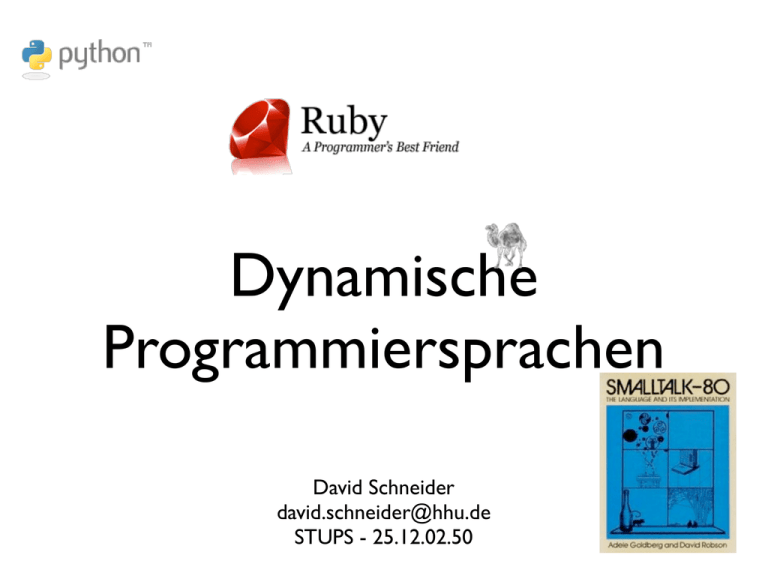
Dynamische Programmiersprachen David Schneider [email protected] STUPS - 25.12.02.50 Organisatorisches • Aufbau: • Vorlesung 2 SWS • Übung • Kurzreferat • Projekt • Prüfung Übung • wöchentliches Aufgabenblatt • in 2er Gruppen zu bearbeiten (Pair-Programming) • keine Pflichtabgaben • jede Gruppe muss mind. 1 Lösung vorstellen • Terminfindung Kurzreferat • Kurzreferat über eine Dynamische Programmiersprache • Gruppen aus der Übung • Themenverteilung nächste Vorlesung • 10min • Intro, Features • Warum ist diese Sprache eine Dynamisches Sprache? Projekt • baut auf dem Interpreter aus den Übungen auf • im Team zu bearbeiten • Kriterien wie Testing, Dokumentation, Code-“Qualität”, Verwendung von DVCS, etc. werden bewertet. • in der Vorlesungsfreien Zeit • 20% der Note Prüfung • am Ende der vorlesungsfreien Zeit (Ende September) • Form je nach Teilnehmerzahl Überblick • Dynamische Sprachen • Außen • • Python, Smalltalk • Objektorientierung • Meta-Programmierung • … Innen • Interpreter • AST/Bytecode • Garbage Collection • … Ziel • Eigenschaften von Dynamischen Sprachen lernen und verstehen • Einblick in verschiedene Sprachen • Lernen, wie Interpreter und VMs aufgebaut sind • soziale Aspekte Dynamischer Sprachen kennen lernen Why? “Sapir–Whorf Hypothesis” Dynamic Languages Dynamic Languages "The term dynamic programming language describes a class of programming languages that share a number of common runtime characteristics that are available in static languages only during compilation, if at all.[…]” T. Mikkonen and A. Taivalsaari, “Using JavaScript as a real programming language” 2007. Dynamic Languages “[…]These behaviors can include the ability to extend the currently running program […] even by modifying the internals of the language itself, all during program execution. While these behaviors can be emulated in almost any language […] such behaviors are integral, built-in characteristics of dynamic languages.” T. Mikkonen and A. Taivalsaari, “Using JavaScript as a real programming language” 2007. (Some) Properties of Dynamic Languages • Interactive • Everything is an object • Dynamic Typing • Most things changeable at run-time • Reflection • “Late-Bound Everything” (Some) Properties of Implementations • Garbage Collected • Interactive • Interpreted Interactive • REPL (Read-Evalutate-Print-Loop) • Type and immediately execute parts of programs Everything is an Object • Numbers, functions, classes, instances, lists, modules, etc. • No distinction between primitives and "objects" • All objects are manipulated the same way Dynamic Typing • Types not declared • Types attached to values at run-time a a a a = = = = 1 "lorem ipsum" [1, 'a', 1.0] {'a': 1, 2: [1,2]} Most Things Changeable at Run-Time • • Most things changeable at run-time, e.g.: • The bindings • All objects (classes, methods, modules…) Reflection: • The way in which we can inspect (and change) the running program from within itself • Non-modifying reflection is sometimes called introspection. “Late-Bound Everything” • Late Binding: • The object that a variable name references can only be determined at run-time. Garbage Collected • Garbage Collection: • No manual memory management Interpretation • Interpreter: • Executes a program written in a language without compilation step • AST/Bytecode So What Defines a Dynamic Language? Runtime everything Dynamic Typing Interactive Everything is an object Virtual machines Interpreted Late binding Garbage Collected Reflection Duck typing Technical and “Social” Consequences • Rapid prototyping • Ease of development • Encourage testing • Easy to use • Simple deployment • Coding to interfaces rather than to implementations Examples • • Lua • Web-Applications • Games/Scripting Python • Javascript • Perl • Automation • Ruby • Prototyping • Smalltalk • ... • PHP How About? • Prolog • Java, C# • Assembler • Haskell, C++, Ada, ML, Pascal, Fortran, Cobol... • First release in 1991 • Guido van Rossum • Two relevant versions 2.7 and 3.4 • Many Implementations: • Reference CPython • Alternative Jython, IronPython, PyPy The Zen of Python (Extract) • Beautiful is better than ugly. • Explicit is better than implicit. • Simple is better than complex. • Complex is better than complicated. • Flat is better than nested. • Readability counts. • There should be one — and preferably only one — obvious way to do it. • If the implementation is hard to explain, it's a bad idea. • If the implementation is easy to explain, it may be a good idea. >>> import this Tools for This Semester • Python Documentation • https://docs.python.org/3/ • https://docs.python.org/2/ • PIP: https://pip.readthedocs.org/ • Virtualenv: http://www.virtualenv.org/ • DVCS: • git: http://git-scm.com • mercurial: http://mercurial.selenic.com
